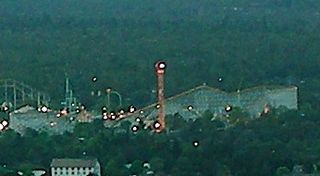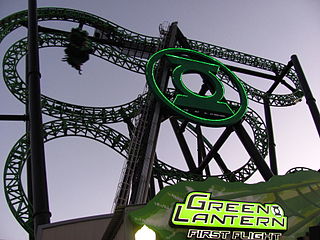
A roller coaster inversion is a roller coaster element in which the track turns riders upside-down and then returns them to an upright position. Early forms of inversions were circular in nature and date back to 1848 on the Centrifugal railway in Paris. These vertical loops produced massive g-force that was often dangerous to riders. As a result, the element eventually became non-existent with the last rides to feature the looping inversions being dismantled during the Great Depression. In 1975, designers from Arrow Development created the corkscrew, reviving interest in the inversion during the modern age of steel roller coasters. Elements have since evolved from simple corkscrews and vertical loops to more complex inversions such as Immelmann loops and cobra rolls. The Smiler at Alton Towers holds the world record for the number of inversions on a roller coaster with 14.
Anton Schwarzkopf was a German engineer who founded Schwarzkopf Industries GmbH, a German manufacturer of roller coasters and other amusement rides that were sold to amusement parks and travelling funfairs around the world.

Six Flags Magic Mountain, formerly known and colloquially referred to as simply Magic Mountain, is a 209-acre (85 ha) amusement park located in Valencia, California, 35 miles (56 km) northwest of downtown Los Angeles. It opened on May 29, 1971, as a development of the Newhall Land and Farming Company and Sea World Inc. In 1979, Six Flags purchased the park and added "Six Flags" to the park's name.

Six Flags Great America is a 304-acre (123 ha) amusement park located in Gurnee, Illinois, within the northern Chicago metropolitan area. The amusement park originally opened as Marriott's Great America on May 29, 1976, as one of two theme parks built by the Marriott Corporation. Six Flags acquired the amusement park in 1984 after the theme park division was an earnings disappointment for Marriott. The sale gave Six Flags rights to the Looney Tunes intellectual properties.

Batman: The Ride is an inverted roller coaster based on the DC Comics character Batman and found at seven Six Flags theme parks in the United States. Built by consulting engineers Bolliger & Mabillard, it rises to a height of between 100 and 105 feet and reaches top speeds of 50 mph (80 km/h). The original roller coaster at Six Flags Great America was partially devised by the park's general manager Jim Wintrode. Batman: The Ride was the world's first inverted roller coaster when it opened in 1992, and has since been awarded Coaster Landmark status by the American Coaster Enthusiasts. Clones of the ride exist at amusement parks around the world.

Nemesis Reborn, previously known as simply Nemesis, is an inverted roller coaster located at the Alton Towers theme park in Staffordshire, England. Manufactured by Bolliger & Mabillard (B&M), the ride was designed by Werner Stengel, while overall development was overseen by attraction developer John Wardley. It opened in the Forbidden Valley area of the park on 19 March 1994.
Ocean View Amusement Park was an amusement park at the end of Granby Street at Ocean View Avenue in Norfolk, Virginia, USA, opened in 1905 and operated by Jack L. Greenspoon and Dudley Cooper. The amusement park and its wooden coaster, the Rocket, appeared in the 1977 movie Rollercoaster but closed on September 4, 1978. The Rocket was destroyed as part of the making of the television program The Death of Ocean View Park in 1979.
James Goldstone was an American film and television director whose career spanned over thirty years.

Roller Coaster DataBase (RCDB) is a roller coaster and amusement park database begun in 1996 by Duane Marden. It has grown to feature statistics and pictures of over 10,000 roller coasters from around the world.

Twisted Colossus is a steel roller coaster located at Six Flags Magic Mountain in Valencia, California. Originally designed and built by International Amusement Devices, the roller coaster opened as Colossus, a dual-tracked roller coaster, on June 29, 1978. It was the tallest and fastest wooden roller coaster in the world and the first with two drops greater than 100 feet (30 m). Colossus became well known after appearances in film and television, including the box-office hit National Lampoon's Vacation and the made-for-TV movie Kiss Meets the Phantom of the Park. For 19 years, it was the park's main attraction until the opening of Superman: The Escape.

Goliath is a steel roller coaster located at Six Flags Magic Mountain amusement park in Valencia, California. Manufactured by Giovanola of Switzerland, the hypercoaster is located in the Goliath Plaza section of the park and opened to the public on February 11, 2000. Its sub-tropical theme is characterized by ancient ruins of the Mayan civilization. The ride is nearly identical to Titan at Six Flags Over Texas, but it lacks a 540-degree upward helix prior to the mid-course brake run and features a slightly shorter track layout.

Nemesis Inferno is a steel inverted roller coaster at the Thorpe Park theme park in Surrey, England, UK. Its layout was conceived and designed by John Wardley and then built by Bolliger & Mabillard with Werner Stengel providing the layout calculations, the same Swiss firm that built the related Nemesis inverted roller coaster at Alton Towers. As a result, Nemesis and Nemesis Inferno are often compared. It is also listed on the Alton Towers website that the ride is “Nemesis’ Sister”.

SooperDooperLooper is a steel roller coaster at Hersheypark in Hershey, Pennsylvania, United States. Designed and manufactured by Anton Schwarzkopf, the roller coaster opened to the public on May 8, 1977. SooperDooperLooper is located in The Hollow section of the park and cost more than $3 million to construct and build. The roller coaster reaches a maximum height of 70 feet, with a maximum speed of 45 miles per hour (72 km/h), and a total track length of 2,614 feet.
A roller coaster is a type of amusement ride.

Adventureland is an amusement park in East Farmingdale, New York, located on Route 110. Adventureland has been Long Island's main amusement park since 1962. There are a total of twenty eight rides, two of which are roller coasters and three are water rides. Adventureland is opened seasonally: weekends in March, April, May, September and October and all days in the summer. Alvin Cohen and Herb Budin bought seven acres of property in 1962 and opened a restaurant, an arcade and mini golf. Along with the building, there were four rides brought to Long Island for entertainment. The original four rides were the Carousel, the Iron Horse train, Little Dipper Coaster, and boats. Willy Miller bought Adventureland from Alvin Cohen on September 15, 1977. Throughout the years, Willy Miller brought in new rides and expanded Adventureland's activities. In 1987, the park was sold to Tony Gentile and Peter Amoruso. In 1991, they began to add water rides to Adventureland. Adventureland celebrated its 50th anniversary in 2012 and 60th anniversary in 2022. The park is a popular attraction for children, schools and day camps on Long Island.

Montaña Rusa was a wooden roller coaster at La Feria Chapultepec Mágico in Mexico City, Mexico. In 1993, it was renamed Serpiente de Fuego but later it was changed back to Montaña Rusa. For several years, Montaña Rusa held the record of world's tallest roller coaster. With the conversion of Medusa at Six Flags México into a hybrid roller coaster in 2014, Montaña Rusa was the last wooden roller coaster in Mexico. In 2020, it was announced that Montaña Rusa would be removed from the park. The coaster was dismantled in July 2022.

Green Lantern: First Flight was a steel roller coaster formerly located at Six Flags Magic Mountain in Valencia, California, United States. The ZacSpin model from Intamin was the first of its kind in the US when it opened on July 1, 2011. Its debut allowed Magic Mountain to reclaim its status of having the most roller coasters in the world.

Pleasure Beach Resort, formerly known as Blackpool Pleasure Beach, is an amusement park situated on Blackpool's South Shore, in the county of Lancashire, North West England. The park was founded in 1896 by A. W. G. Bean and his partner John Outhwaite. The current managing director is Amanda Thompson.

Cannibal is a steel roller coaster located at Lagoon amusement park in Farmington, Utah. It opened with the tallest beyond-vertical drop in the world on July 2, 2015, and its drop angle of 116 degrees was the steepest in the United States for a brief time. A large portion of the $22-million ride was built and designed in-house, a rare move for an amusement park. Since its debut, Cannibal has also consistently ranked in the top 50 among steel roller coasters worldwide in the annual Golden Ticket Awards publication from Amusement Today.
This is a list of events and openings related to amusement parks that occurred in 2015. These various lists are not exhaustive.















